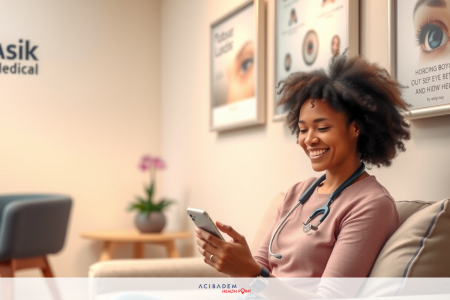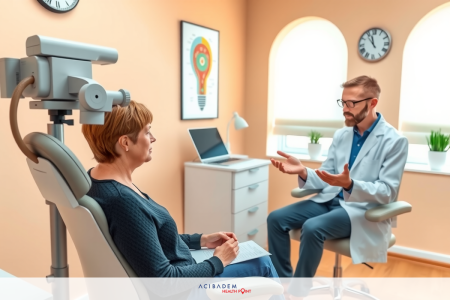Hypertropia in Adults: Causes, Symptoms, Treatment
Hypertropia in Adults: Causes, Symptoms, Treatment Adults can get hypertropia, a condition where the eyes don’t line up. One eye is higher than the other. It can really change how you live your life every day. Knowing why it happens, spotting the symptoms, and learning about treatments are key to dealing with this issue.
This guide will dive deep into adult hypertropia, covering everything from its causes to how it’s treated. If you, or someone you know, is facing this challenge, you’ll find helpful tips here. It’s all about improving your understanding and management of hypertropia in adults.
What is Hypertropia?
Hypertropia is when one eye points up, unlike the other. The non-affected eye stays in its normal spot. This condition messes with your vision and can cause problems if not treated. Knowing what hypertropia is can help detect and treat it right.
Definition
Hypertropia makes your eyes not line up right up and down. It’s often because of muscle issues or nerve problems. This makes one eye see things higher than the other. As a result, you might see double or feel like your eyes are working too hard. This is especially a concern in adults with hypertropia.
Types of Hypertropia
There are different kinds of hypertropia, based on how they happen:
- Congenital Hypertropia: Happens at birth and is due to eye muscle issues.
- Acquired Hypertropia: Shows up later due to injuries, nerve problems, or muscle weakness.
- Intermittent Hypertropia: This one appears now and then, not all the time. It might come when you’re tired.
Each type of hypertropia has its own difficulties. Different tests and treatments are needed for each. It’s super important to know about the different types, especially for treating adults with hypertropia.
Hypertropia Symptoms
Getting to know the signs of hypertropia early is really important. One clear sign in adults is eyes that don’t look straight. This might bother the person, even if the eye turn is small.
Seeing double is another big sign. It makes things look blurry or like there are two of them. This makes daily things harder, like reading or driving.
Feels like your eyes are working too hard after a lot of focus. This can cause headaches. It also makes it tough to get things done during the day.
Some may find it hard to tell how far away things are. This can make walking on bumpy paths or using stairs hard. Not treating hypertropia can make vision worse and increase the chance of falling.
How often and how bad these signs are can change. But, seeing a doctor quickly can help avoid issues. Knowing and understanding the signs is a big part of staying well.
Doctors say finding hypertropia early is key for better results. By learning the signs, people can get help when they need it. This can make life much better.
Common Causes of Hypertropia in Adults
It’s important to know the hypertropia causes to treat it well. Adult hypertropia comes from different things. This includes problems with the brain, muscle issues, and injuries.
Neurological Factors
Neurological problems are key in adult hypertropia. Things like brain injuries and strokes make eye muscles not work well together. This can make one eye move up. Research shows this happens a lot in adults with hypertropia.
Muscle Imbalance
Eye muscle problems are a big reason for hypertropia. If some eye muscles are weaker or longer than they should be, your eyes might not line up. This can happen because of things you’re born with, getting older, or health problems.
Traumatic Injuries
Injuries like accidents and surgeries can also cause hypertropia. If the muscles or nerves in your eyes get hurt, your eyes might not move right. There are cases where injuries to the face or surgeries caused hypertropia. This shows it’s a key thing to know about in adults with hypertropia.
Diagnosis of Hypertropia
Diagnosing hypertropia for adults is very thorough. Doctors use many tests to find the problem. One key test is the cover test. This test checks how well the eyes move and line up by covering one eye at a time.
They also do detailed eye exams. These check both inside and outside the eye. Specialists might use special tools during these exams.
Some adults need more tests like OCT and MRI. These give a close look at the eye’s details. They help find the cause of hypertropia.
In a comprehensive eye exam, certain steps are taken:
- Visual acuity test to check vision sharpness
- Refraction check for the correct lens prescription
- Tests on eye alignment and focusing
- Coordination check for how eyes work together
- Observing eye movement in the ocular motility test
Ophthalmologists and optometrists are key in diagnosing hypertropia. Their skills help pinpoint the problem’s type and extent. A precise diagnosis leads to a better plan to treat hypertropia in adults.
Early detection and constant care are very important. Following the right steps in diagnosis ensures the best care for hypertropia.
Hypertropia Treatment Options
When someone is diagnosed with hypertropia, the treatment plan is made just for them. It depends on the person’s needs and how serious the condition is. Treatments can be done with or without surgery.
Non-Surgical Treatments
For adults with hypertropia, non-surgical options are common:
- Vision Therapy: Special exercises to make eyes work better together.
- Prisms in Glasses: Lenses in glasses that help eyes see in the right direction.
- Medications: Some medicines can relax the eye muscles and ease the problem.
Doctors choose these non-surgical treatments based on a patient’s specific case and response to past treatments. Vision therapy and prisms are great for milder cases. Medicines can also be used with other treatments.
Surgical Treatments
For more serious or ongoing hypertropia, surgery might be needed. Surgeries work to fix the muscle problems causing the eye misalignment:
- Recession Procedure: Moves a muscle to reduce its pulling.
- Resection Surgery: Makes a muscle shorter to make it stronger.
- Adjustable Sutures: Stitches that can be changed after surgery to get better results.
Surgery for hypertropia needs a lot of thought and talks with a doctor. Studies show that surgery can help a lot, making eyes align better and vision clearer for many adults.
Adult Hypertropia Surgery
When other methods don’t work well, adults might need surgery for hypertropia. This aims to fix eye misalignment. It helps both how the eyes work and how they look.
Here are some surgeries for hypertropia:
- Recession Surgery: Repositions the eye muscles to fix overactivity.
- Resection Surgery: Strengthens weaker eye muscles for better balance.
- Adjustable Suture Surgery: Uses adjustable sutures for precise muscle position.
Before surgery, a detailed assessment is crucial. This checkup covers:
- Looking at your medical past to spot risks.
- Testing your eyes to see how they’re off and their health.
- Talking with a specialist about what to expect and health issues that could matter.
It’s important to know surgery’s pros and cons. Here’s what to compare:
| Aspect | Benefits | Risks |
|---|---|---|
| Vision Improvement | Aligns vision better, improves how you see depth | You might see double for a while |
| Aesthetic Correction | Looks of the eyes get better, which can boost self-esteem | Scars may show, but they’re usually not big |
| Recovery Time | Gets better quickly, and you’ll see changes in weeks | Getting sick or bad reactions are not common, but they can happen |
Real patient stories can help a lot. Many say surgery for hypertropia really helped them. It changed how well they see and their life for the better.
As we learn more, adult hypertropia surgery keeps getting better. Studies and doctor reports show that surgery is a key way to treat this eye problem in grown-ups.
The Role of Hypertropia Exercises
Exercises are key to helping people with hypertropia. They aim to make the eyes’ muscles stronger. And they help the eyes work better together, bringing comfort to those with the condition.
Here’s how specific exercises can aid those with hypertropia:
- Focusing Exercises: These involve alternating focus between a nearby and distant object. This helps in enhancing convergence and divergence skills.
- Tracking Exercises: Following a moving object with your eyes can improve coordination. Common activities include tracing a finger or a penlight in different patterns.
- Strengthening Exercises: Eye muscle strengthening can be achieved through repetitive directional eye movements, aiding the alignment of the eyes.
Eye doctors recommend these special exercises. They have seen good results in their patients. Doing these exercises often can make a big difference in how well your eyes work together.
| Exercise Type | Description | Benefits |
|---|---|---|
| Focusing Exercises | Alternate focus between a near and far object. | Enhances convergence and divergence skills. |
| Tracking Exercises | Follow a moving object with the eyes. | Improves visual coordination. |
| Strengthening Exercises | Repetitive directional eye movements. | Strengthens eye muscles, aiding alignment. |
Doing these exercises daily can really help with hypertropia. But, it’s important to work with an eye doctor. They can make a plan just for you, helping your eyes get better.
How to Manage Hypertropia Daily
Managing hypertropia in adults is complex but doable with the right approach. Wearing prism glasses can align the eyes, lessening double vision. It’s key to get the right prescription from an eye doctor.
Changing your work and home spaces is also vital. Good lighting and screen glare reduction help. Positioning your monitor right and taking eye breaks boost comfort and efficiency.
Support from friends and in groups is important. Talking to others with hypertropia can help a lot. It’s also good to deal with any feelings through therapy. Health professionals and therapists can give advice on how to live well with this condition.
FAQ
What is hypertropia in adults?
Hypertropia in adults is when one eye looks upward more than the other. This can make you see double and feel like your eyes are working too hard.
What are the common symptoms of hypertropia in adults?
If you have hypertropia, you might see double. Your eyes could also feel tired and you might get headaches. It can be hard to judge how far things are.
What causes hypertropia in adults?
Different things can lead to hypertropia in adults. This includes issues with the brain, eye muscles not working well, or injuries to the eye.
How is hypertropia diagnosed?
Doctors check for hypertropia with eye tests. They watch how your eyes move and might use special tools to look inside your eyes.
What are the treatment options for hypertropia in adults?
For adult hypertropia, treatment might include special glasses, eye exercises, and sometimes medicine. In severe cases, surgery could be an option.
Are there any surgical treatments for hypertropia in adults?
Yes, surgery can fix hypertropia in adults in certain situations. Eye specialists do the surgeries that aim to make the eyes align better.
How can hypertropia exercises help in managing the condition?
Doing eye exercises can help make eye muscles stronger. This can help fix eye alignment issues without needing surgery.
How can hypertropia be managed daily?
Every day, people with hypertropia may need to wear special glasses. They should also try to make their home and work spaces easier on the eyes. Eye exercises are also important.Getting support from friends and family is key for your mental health. They should understand the challenges hypertropia can bring.
What is the role of Acibadem Healthcare Group in treating hypertropia?
Acibadem Healthcare provides full care for hypertropia. They offer everything from checking for the condition to different treatments, including surgery. They have skilled doctors and the latest tech to help manage hypertropia well.













